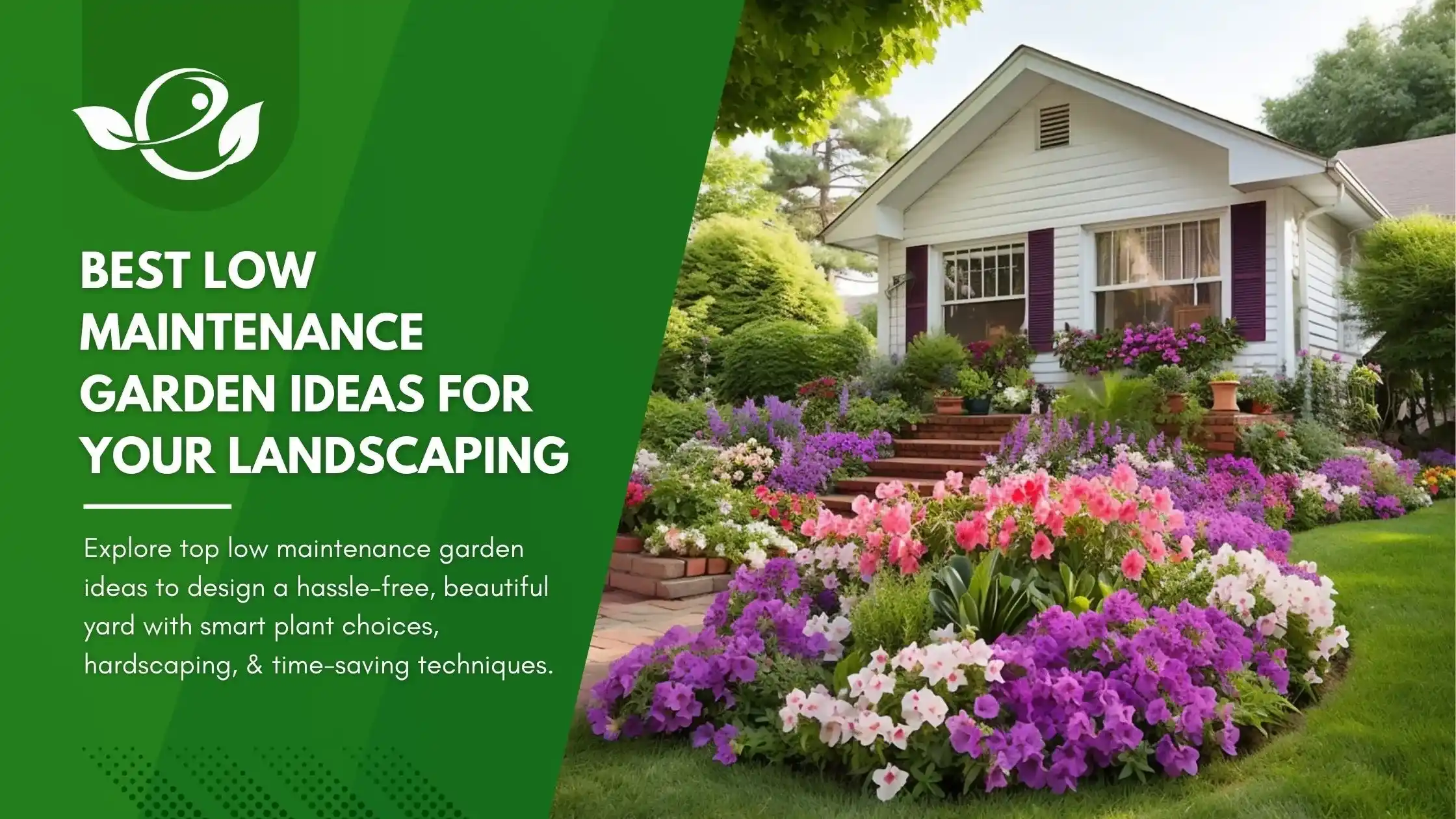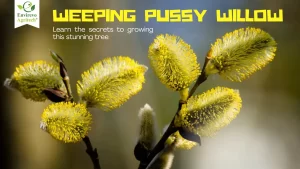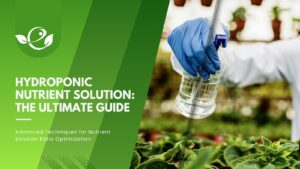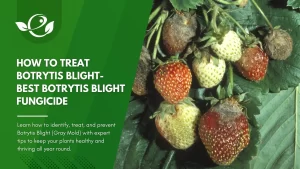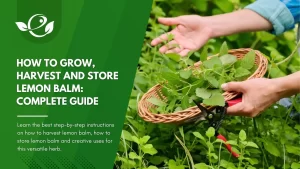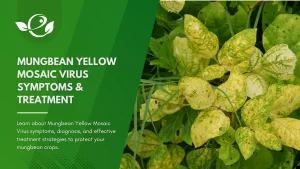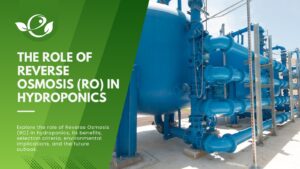Table of Contents
Designing and maintaining a garden often feels overwhelming, especially for busy homeowners who struggle to keep up with regular care. However, a low-maintenance garden can change the way you experience outdoor living. By strategically selecting plants, incorporating smart landscaping techniques, and leveraging modern tools, you can craft a beautiful and functional garden that fits seamlessly into your lifestyle. This article delves into expert-approved tips and ideas for creating a garden that thrives with minimal effort, proving that a dream outdoor space doesn’t have to come with constant upkeep.
Understanding Low Maintenance Gardening
What is a Low Maintenance Garden?
A low-maintenance garden is designed to minimize the time and effort needed for upkeep while still offering visual appeal, functionality, and sustainability. It involves strategic choices in plant selection, landscaping materials, and design to reduce labor-intensive tasks like watering, weeding, pruning, and mowing.
Key Principles of Low Maintenance Garden Ideas
- Smart Plant Choices: Use drought-tolerant, perennial, or native plants to reduce watering and fertilizing needs.
- Functional Design: Incorporate hardscaping elements and group plants with similar needs.
- Efficient Practices: Utilize mulching, automated irrigation, and low-maintenance lawn alternatives.
Best Low Maintenance Garden Ideas
When designing a small Low Maintenance garden, it can be very tempting to maximize the space by cramming in various plants, outdoor furniture, and decorative elements like garden art. More is often seen as better, and the desire to create an inviting and vibrant outdoor area can lead to overcrowding. However, A simpler approach to garden design can actually save you time and effort while enhancing the beauty of your space. By focusing on easy-to-maintain elements, you’ll not only enjoy a stunning garden but also spend less time on upkeep. It’s a win-win for both your aesthetic goals and your schedule!
1. Drought-Tolerant Plantings
Drought-tolerant plants are an essential feature of any low-maintenance garden, especially in regions prone to water scarcity or for homeowners looking to reduce their water bills. These plants are adapted to survive with minimal water, making them perfect for creating a lush, green space that thrives even in dry conditions.
- Examples: Popular choices include succulents like aloe vera and echeveria, aromatic herbs such as lavender and rosemary, tough perennials like yucca, and striking ornamental grasses like blue fescue.
- Benefits: Beyond their water-saving properties, drought-tolerant plants are often pest-resistant and require little fertilizing or pruning. Their robust nature makes them excellent for gardeners seeking a “set it and forget it” approach.
- Pro Tip: Use well-draining soil to keep these plants healthy and avoid overwatering.
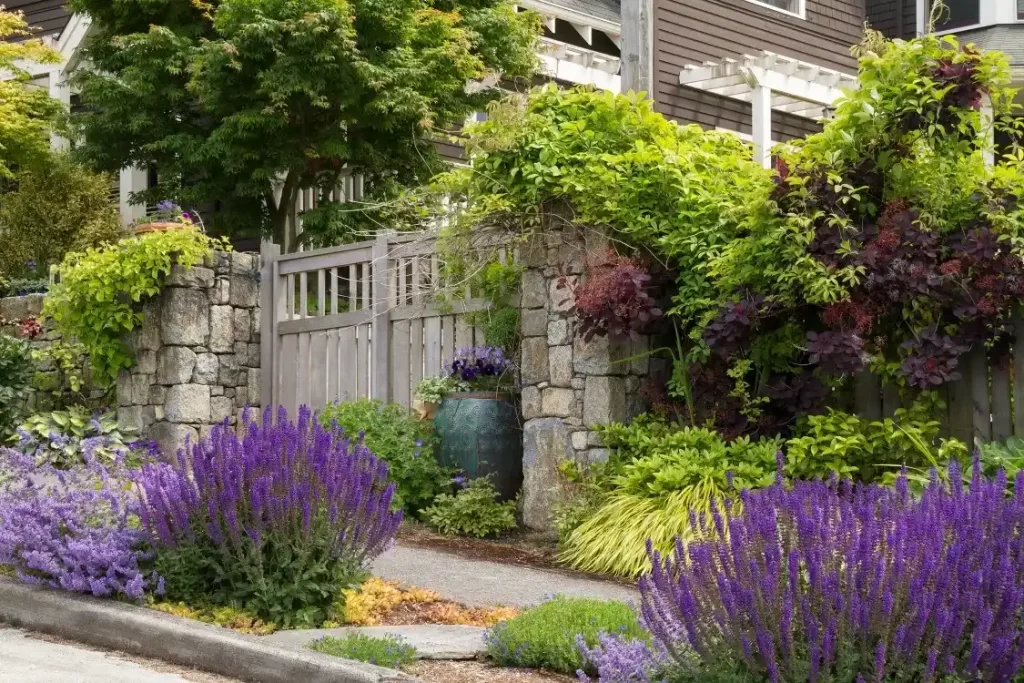
2. Native Plant Landscaping
Native plants are a cornerstone of low-maintenance gardening, as they are perfectly suited to the local climate and soil conditions. These plants have evolved to thrive in their native environments, making them incredibly resilient and requiring minimal care.
- Benefits: Native plants help preserve biodiversity by supporting local pollinators such as bees, butterflies, and birds. They are naturally resistant to local pests and diseases, reducing the need for chemical treatments. Additionally, they require less water, fertilizer, and pruning compared to exotic species.
- Examples: Depending on your region, popular native plants may include goldenrod, milkweed, black-eyed Susan, prairie grasses, or wildflowers like coneflowers and lupines.
- Design Tip: To create a visually appealing and eco-friendly landscape, mix native plants with drought-tolerant species. Use native shrubs and trees as structural elements and fill in with colorful perennials or ground covers. Add layers of texture and height for a dynamic and natural look.
- Pro Tip: Research the native plants specific to your region to ensure the best results. Partnering with local garden centers or extension services can provide valuable insights into the most suitable options.
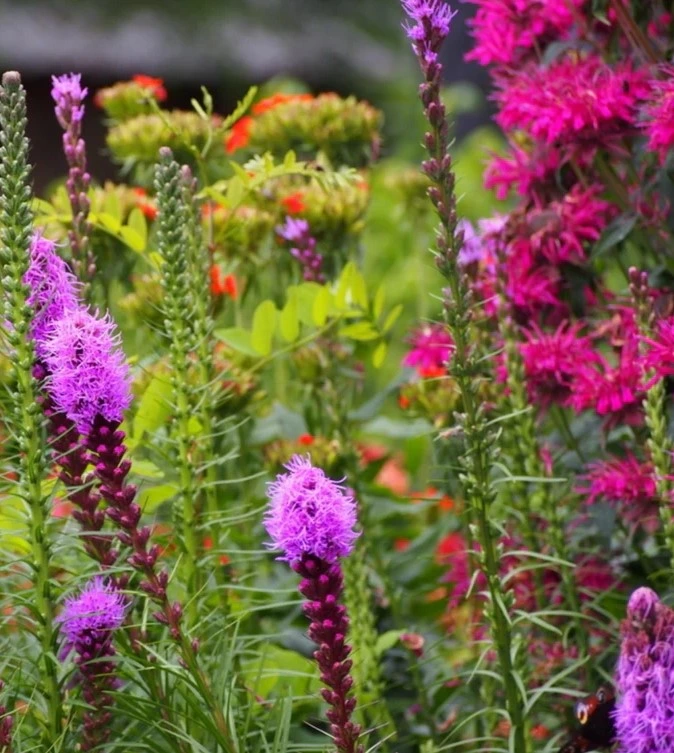
3. Perennial Ground Covers
Perennial ground covers are an excellent choice for creating a low-maintenance garden while maintaining visual interest. These plants spread quickly, forming dense mats that suppress weeds, reduce soil erosion, and minimize the need for regular mulching or watering.
- Examples: Popular perennial ground covers include creeping thyme, sedum, ajuga, and vinca. Creeping thyme offers a fragrant and hardy option, while sedum thrives in dry, sunny conditions. Ajuga provides rich foliage colors, and vinca is known for its adaptability to shady areas.
- Benefits: By covering bare soil, these plants help retain moisture, regulate soil temperature, and reduce the need for constant weeding. They also add year-round greenery, with some varieties featuring seasonal blooms for added color.
- Pro Tip: Plant perennial ground covers in areas where grass struggles to grow, such as under trees or on slopes. To ensure rapid establishment, choose species suited to your local climate and soil type. Regularly trim or divide them as needed to prevent overgrowth and maintain a neat appearance.
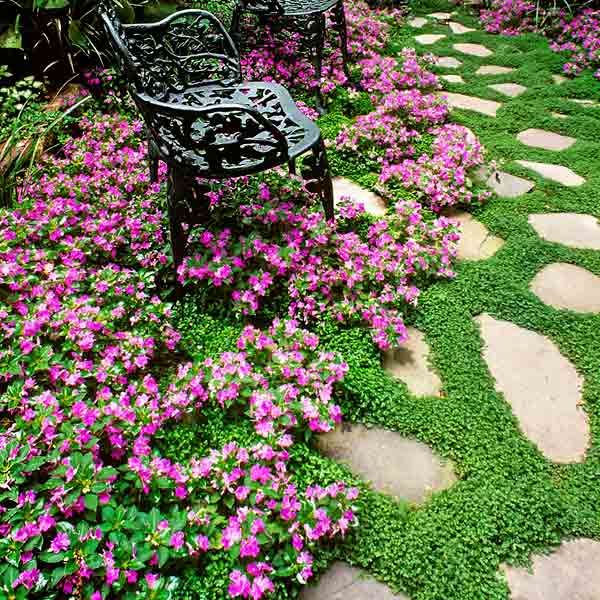
4. Use Hardscaping Elements
Hardscaping involves incorporating non-living elements into your garden design, which can significantly reduce the need for constant upkeep. These features not only enhance the garden’s aesthetic appeal but also provide structure and functionality.
- Ideas: Consider adding stone pathways, gravel beds, wooden decks, patios, or retaining walls. These elements create a clean, polished look and help define different garden zones. Incorporating water features like fountains or small ponds can add tranquility while requiring minimal maintenance.
- Benefits: Hardscaping reduces the reliance on grass and other high-maintenance plants, thereby lowering watering, mowing, and fertilizing needs. It also minimizes soil erosion, improves drainage, and makes your garden more accessible year-round.
- Materials: Use permeable materials such as gravel, flagstone, or pavers to allow water infiltration and prevent runoff. For retaining walls or edging, materials like natural stone or treated wood can create a lasting and visually appealing effect.
- Pro Tip: Combine hardscaping with softscape elements like ground covers or native plants to balance the design. Adding seating areas or fire pits can also turn your garden into an inviting outdoor living space.
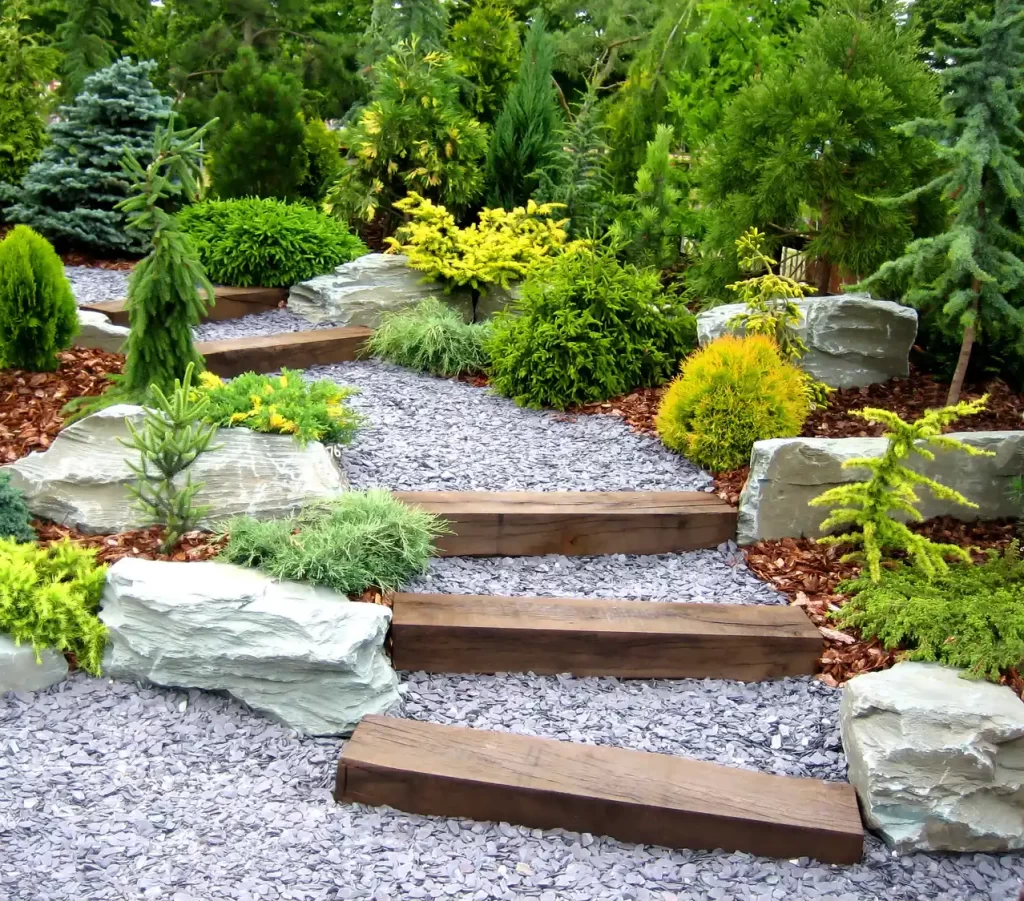
5. Install Automated Irrigation Systems
Automated irrigation systems are an indispensable tool for maintaining a low-maintenance garden, ensuring your plants get the water they need without constant oversight. These systems are designed to deliver water efficiently and precisely, saving both time and resources.
- Options: Common options include drip irrigation systems, soaker hoses, and smart sprinklers. Drip irrigation delivers water directly to the root zones, minimizing evaporation. Soaker hoses gently distribute water along their length, making them ideal for beds and rows. Smart sprinklers can be programmed to water specific areas at optimal times based on weather data.
- Benefits: These systems reduce water waste by targeting specific areas, prevent overwatering that can harm plants, and allow for flexible scheduling. They are particularly useful in regions with water restrictions or for gardeners with busy lifestyles.
- Pro Tip: Combine automated irrigation with a rain sensor or moisture meter to further optimize water use and prevent unnecessary watering during rainy periods. Smart irrigation systems can save time, water, and money.
- Options: Drip irrigation, soaker hoses, or smart sprinklers.
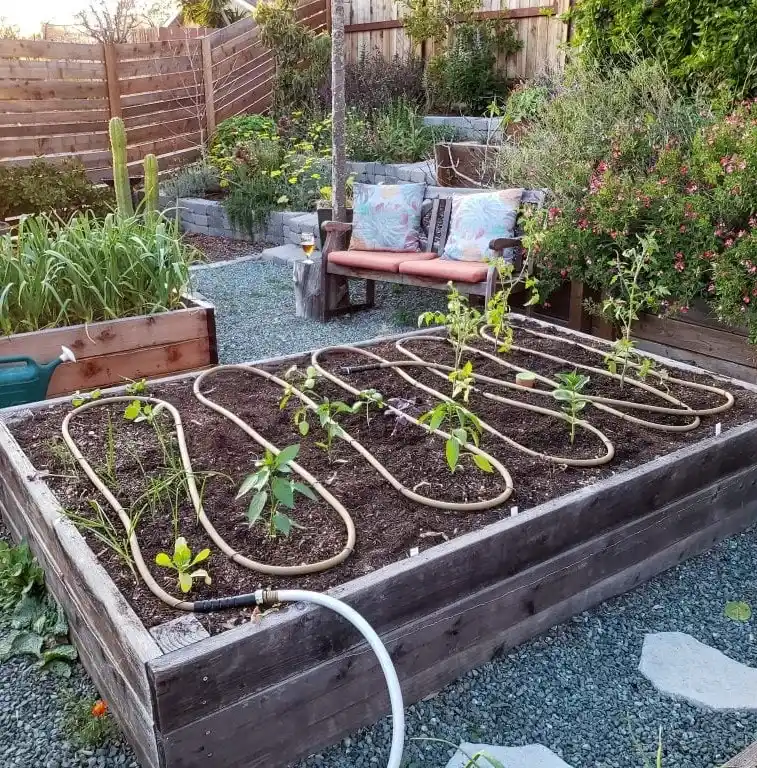
6. Low Maintenance Lawn Alternatives
Replacing traditional grass lawns with low-maintenance alternatives can save significant time, water, and resources while maintaining an attractive outdoor space. These alternatives are designed to thrive with minimal care and often provide additional environmental benefits.
- Clover Lawns: Clover, such as microclover, is a resilient and eco-friendly option. It naturally enriches the soil with nitrogen, reducing the need for fertilizers.
- Ornamental Grasses: Varieties like blue fescue or fountain grass create visual interest with their texture and movement, requiring only occasional trimming.
- Artificial Turf: Synthetic grass offers a lush, green appearance year-round without mowing, watering, or fertilizing.
- Moss: Ideal for shaded or damp areas, moss lawns provide a soft, carpet-like texture that requires no mowing or fertilization.
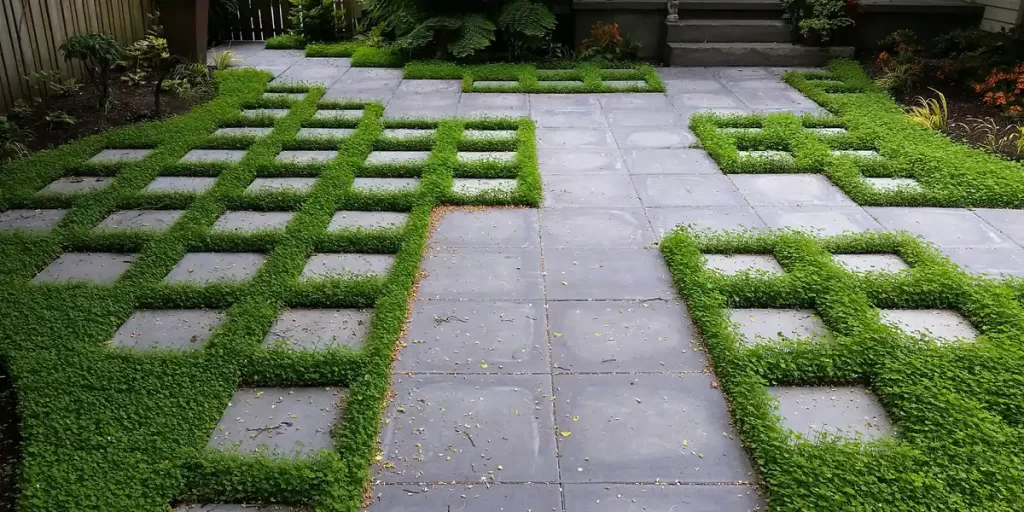
7. Container Gardening (Go large with pots)
Container gardening is an excellent way to introduce flexibility and simplicity into your garden design. By growing plants in pots or planters, you can create stunning displays with minimal maintenance.
- Benefits: Containers allow you to select and control the soil quality, ensuring optimal conditions for each plant. Weeds are less likely to grow in pots, saving time and effort.
- Plant Suggestions: Herbs such as basil, thyme, and parsley thrive in small containers and provide fresh flavors for your kitchen. Bright flowering plants like petunias, marigolds, and geraniums add vibrant colors to patios or balconies.
- Design Ideas: Group containers of varying heights and colors for a layered aesthetic. Use lightweight materials like plastic or fiberglass pots for easier handling.
- Pro Tips: Ensure all containers have adequate drainage holes to prevent waterlogging. Use high-quality potting mix designed for container plants to promote healthy root development.
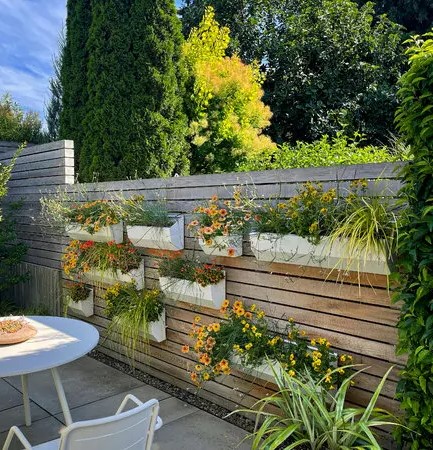
8. Artificial Turf Installation
Artificial turf, also known as synthetic grass, is an increasingly popular choice for creating low-maintenance lawns. It offers a lush, green appearance all year round without the need for constant care and upkeep associated with natural grass.
- Benefits: Artificial turf eliminates the need for mowing, watering, fertilizing, or reseeding, making it an ideal option for busy homeowners or those in drought-prone areas. It also prevents weeds and creates a uniform, polished look for your landscape.
- Types of Artificial Turf: Modern synthetic grass options range from budget-friendly to premium-grade varieties that mimic the look and feel of real grass. Some products include UV protection to maintain color vibrancy over time.
- Installation Tips: Begin by clearing and leveling the area where the turf will be installed. Lay a weed barrier, spread a layer of sand or crushed stone for drainage, and secure the turf with landscaping nails. For added realism, brush the turf fibers to stand upright.
- Pro Tips: Choose high-quality turf with a mix of blade colors and textures for a natural appearance. Incorporate permeable backing to improve drainage and prevent water pooling. Regularly rinse and brush the turf to remove debris and keep it looking fresh.
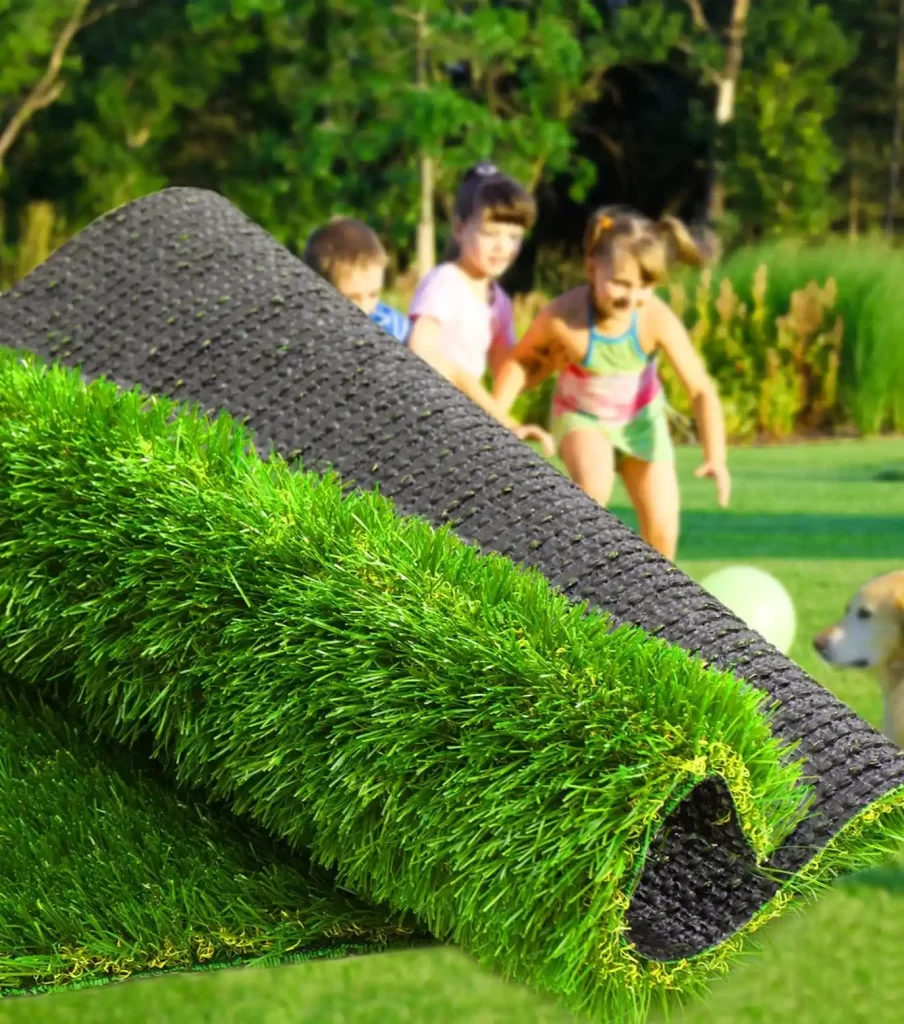
9. Use monkey grass for low-maintenance borders
Monkey grass, also known as Liriope muscari or Liriope spicata, is a versatile, hardy, and low-maintenance plant commonly used for landscaping borders. Its grass-like appearance and robust growth habit make it a popular choice for creating defined, tidy edges in gardens, pathways, and flower beds. Here’s why it’s an excellent choice for low-maintenance borders:
- Key Benefits: Monkey grass requires minimal attention. Once established, it thrives in various conditions without the need for frequent watering, fertilizing, or mowing. It grows well in full sun, partial shade, or deep shade, making it suitable for diverse garden locations.
- Year-Round Appeal: Monkey grass stays green throughout the year and produces attractive purple or white flowers in late summer, adding visual interest to the garden.
- Design Ideas: Use it to line walkways or pathways for a clean and polished look. Frame flower beds or vegetable gardens to create distinct separation and structure.
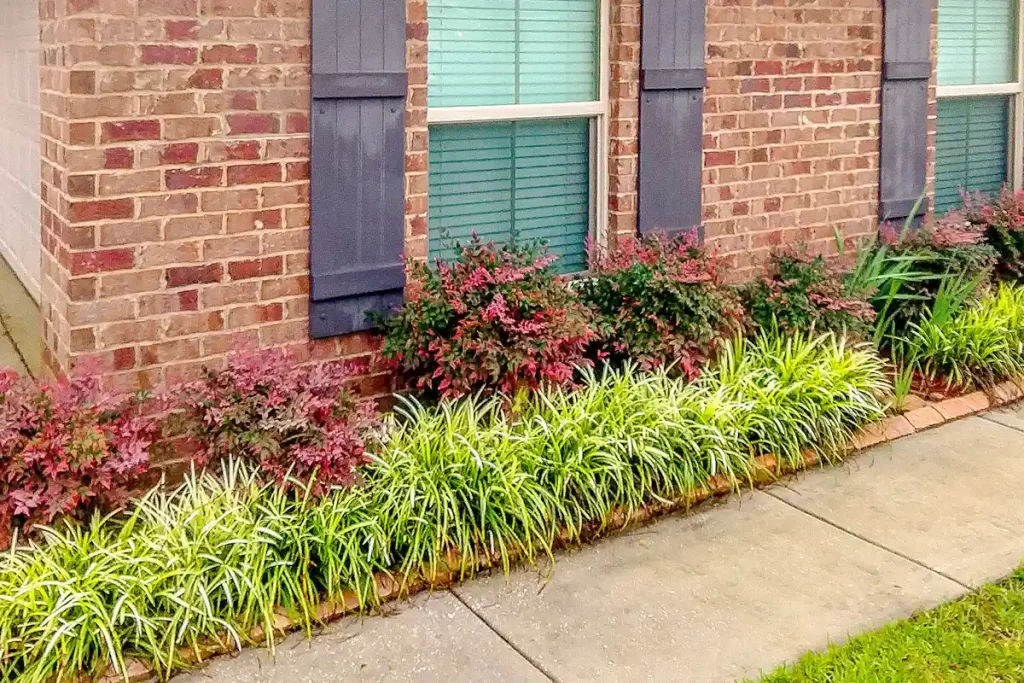
10. Add maintenance-free rock mulch
Rock mulch is a highly durable and low-maintenance alternative to organic mulch, ideal for reducing garden upkeep while enhancing its aesthetics. Unlike organic mulches, such as wood chips or straw, rock mulch does not decompose over time, requiring less frequent replacement.
- Benefits of Rock Mulch: Rock mulch remains in place for years, reducing the need for regular replenishment. A layer of rock mulch effectively blocks sunlight, preventing weeds from sprouting. Rocks allow water to permeate into the soil while minimizing surface runoff. It helps insulate the soil, maintaining stable temperatures around plant roots. Available in various colors, shapes, and sizes, rock mulch complements any landscape design, from modern to rustic.
- Best Practices for Using Rock Mulch: Before laying rock mulch, place a weed barrier fabric to enhance weed control and prevent rocks from sinking into the soil. Apply a 2–3 inch layer of rocks for effective coverage without suffocating plant roots. Use it around shrubs, trees, and pathways, avoiding areas with tender or shallow-rooted plants that may struggle in hotter conditions. Gravel, river rocks, lava rocks, and decomposed granite are popular options, each offering unique textures and colors.
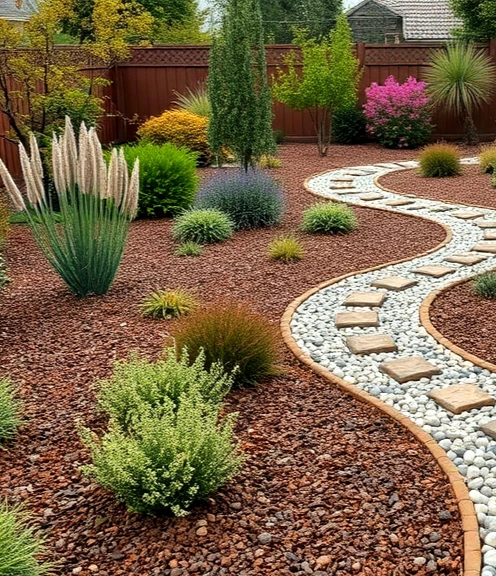
11. Xeriscaping
Xeriscaping is a landscaping method designed to minimize water use, making it ideal for areas prone to drought or where water conservation is a priority. This technique combines practical water-efficient strategies with aesthetic appeal to create sustainable and low-maintenance gardens.
- Core Elements: Drought-tolerant plants, such as succulents, cacti, and certain perennials, require minimal watering and thrive in dry conditions. Mulch helps retain soil moisture and reduces water evaporation. Improving soil with organic matter enhances its water-retention capacity. Techniques like terracing or installing swales help control runoff and maximize water infiltration.
- Benefits: Xeriscaping significantly reduces the need for irrigation, conserving water resources. Lower water bills and reduced maintenance costs make it an economical option. Promotes sustainability by reducing reliance on fertilizers and pesticides.
- Design Tips: Group plants with similar water needs (hydrozoning) for efficient irrigation. Use hardscaping elements like gravel, rocks, and pathways to complement plantings and reduce water demands. Incorporate rainwater harvesting systems to support your xeriscaped garden.
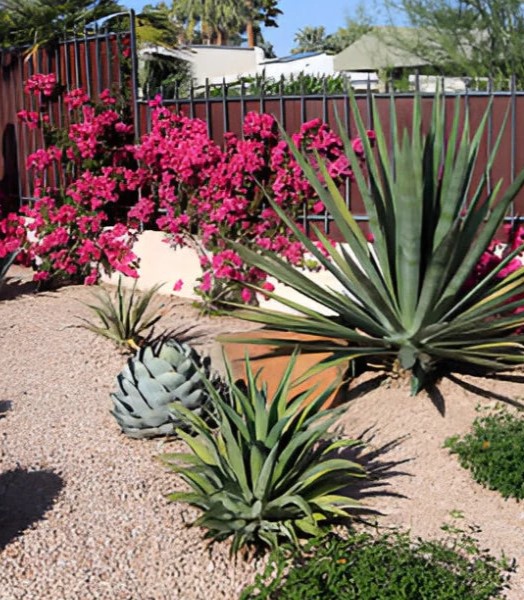
12. Vertical Gardening
Vertical gardening is an innovative way to maximize space in small gardens while adding height and visual interest to your landscape. By growing plants vertically using structures like trellises, wall-mounted planters, or hanging pots, you can create a lush, green ambiance with minimal ground-level maintenance. Utilize vertical space with trellises, wall planters, or hanging pots.
- Benefits: Maximize space, reduce ground-level maintenance, and add visual interest.
- Pro Tip: Choose low-maintenance vines like pothos or philodendrons.
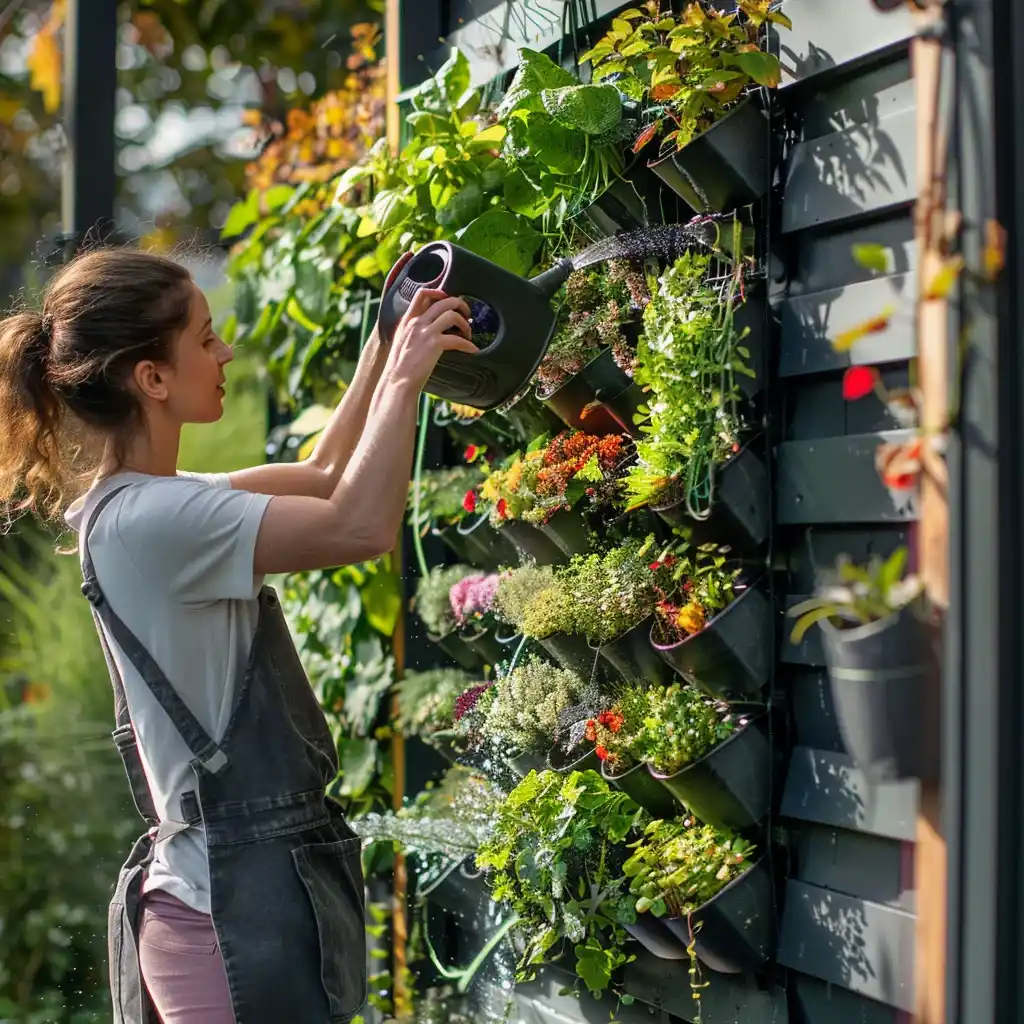
FAQ About Low Maintenance Garden Ideas
What type of garden is easiest to maintain?
A garden with native plants, drought-tolerant species, and perennials is easiest to maintain as they require less water, pruning, and care.
What is the most low maintenance landscaping?
Gravel beds, mulched areas, xeriscaping, and hardscaping with stones or pavers are the most low-maintenance landscaping options.
What is the best low maintenance garden path?
Gravel or stone pathways are the best low-maintenance options, as they are durable, easy to install, and require minimal upkeep.
What is the best low maintenance garden for the elderly?
Raised garden beds or container gardens with easy-to-reach plants like herbs and flowers are ideal for the elderly, minimizing bending and effort.
Are artificial lawns better for low maintenance?
Yes, artificial lawns eliminate the need for mowing, watering, and fertilizing, making them an excellent choice for low-maintenance landscaping.
How often should I prune plants in a low-maintenance garden?
Most low-maintenance plants require pruning once or twice a year, typically during the dormant season or after flowering.
Can I have a vegetable garden that’s low maintenance?
Absolutely! Focus on hardy vegetables like kale, zucchini, and radishes, and consider raised beds or container gardening to reduce weeding and watering.
Is it possible to have a colorful garden with minimal effort?
Yes, plant flowering perennials like black-eyed Susans, coneflowers, and daylilies, which provide vibrant colors with minimal upkeep.
How do I manage pests in a low-maintenance garden?
Encourage natural predators like ladybugs, use companion planting, and opt for organic pest control sprays for minimal effort pest management.
Conclusion
Low-maintenance gardens are an ideal solution for busy homeowners who want a beautiful outdoor space without the constant effort. By implementing these low maintenance garden ideas, you can enjoy a stunning landscape that is both sustainable and easy to care for. Start small, experiment with different strategies, and create a garden that suits your lifestyle and preferences.
Ready to transform your garden? Share your favourite low-maintenance gardening tips or experiences in the comments below!
